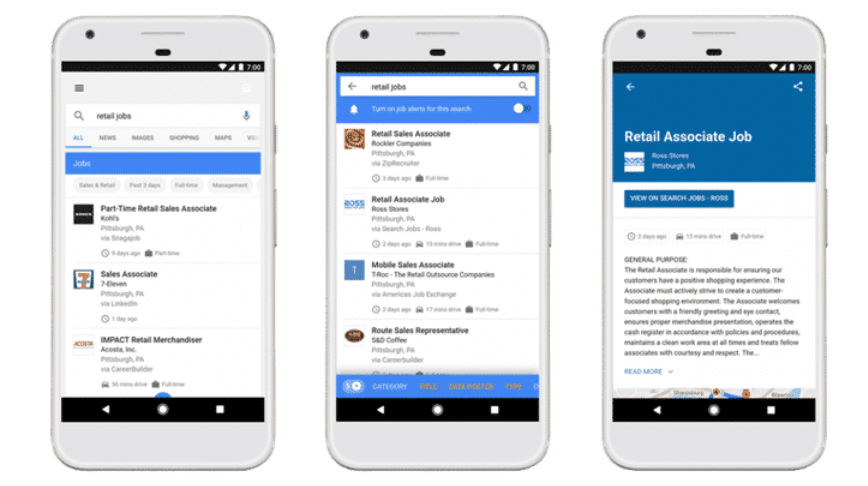Over the years, I’ve seen Google products come and go. Some have succeeded (Maps), others have failed (Google Plus), and some have even returned (Google Lens).
I love Google’s mentality of offering free products, improving them if there’s a take-up, and monetising them. I guess that’s why they are now a US$1 trillion-dollar business.
Whatever the product, I always pay attention and attempt to be an early adopter to maximise my competitive advantage. It is none more so than Google for Jobs.
Since 2017, they’ve launched ‘Google For Jobs’ in markets such as the US, Canada, UK and India, and although there isn’t an official date for it to crash on our shores, it’s coming, and recruiters, job boards and marketers need to prepare.
What is Google for jobs?
It’s an enhanced search feature that aggregates job listings from job boards and career sites and displays them prominently in the Google Search Result Pages (SERPs) to help job seekers find jobs more efficiently.
Using their robust algorithm, personalisation and understanding of semantics, you can use general searches like ‘jobs near me’ and obtain relevant results. Alternatively, search for ‘solicitor jobs in the eastern suburbs’ and get presented with a job that uses the term lawyers and is based in Paddington.
It also pulls in other information to help job seekers make informed decisions: average salary ranges, company employee reviews from sites such as Glassdoor and other job opportunities from the end employer.

The aim is to provide the job seeker with an aggregated view of all available and relevant jobs within one interface: Google. The only reason to leave Google is to apply for the job, but that might change.
Does it work for job advertisers?
Madgex (A Google for Job partner and job board software provider) produced a report earlier this year detailing the tool’s initial effects, most significantly its impact on a website’s entry pages, application rates and SEO rankings. The key out-takes are outlined below.
Entry Pages – Job description pages saw a 25% increase in organic traffic year-on-year. Job seekers find it easier to get to the jobs that interest them rather than spending time on your home page or filter pages, resulting in a better user experience.
Application Rate – Madgex reports that ‘the average application rate has risen by 47%, with some top performers seeing an increase of over 100%.’ This increase is closely aligned with the fact that the job seeker is using Google to find the right job and is coming to your site ready to apply.
SEO Ranking – While Madgex doesn’t report on this metric, it referred to sites obtaining traffic for broad search terms such as ‘jobs near me’, which they previously would not have ranked for.
How do I become Google for jobs ready?
It’s free and relatively easy, so there’s no reason not to prepare. I think marketing recruitment is married to search engine optimisation. Here are the digital and search steps you have to take.
- Google needs to be able to crawl your job pages – You need to be visible to Google. They should not have a no-index request within your robots.txt file. These ‘robots’ exclusions dictate to Google which areas of your site are excluded from their crawls.
- Your host settings allow frequent crawls – If Google wants to crawl your site to see your job listings, don’t hold it back.
- Add, test & preview job listing structured data – Structured data is a way that a website tells several search engines what your content is about. Think video, recipes and reviews.
- Canonical URLs – If multiple or duplicate copies of the same job on your site have different URLs, canonical tags should be on each version. (This tells Google what version of the job listing it should use, as it hates duplicate content).
- Sitemaps – Keeping Google in the know-how should be one of your top priorities. You can do this by submitting a sitemap via Google Search Console.
- Expire the old jobs – When job listings expire on your website, let Google know. Remember, Google wants to provide its users with a great experience and promoting an expired job doesn’t do that.
- Own your job listings – Google will make the final call on whether your website is selected as a potential destination for searchers rather than a job board hosting the same job. To help that happen,
- Metadata: Make sure your job listings have highly optimised and complete meta-data to cater to the keywords you wish to rank for.
- Less External Redirects: Avoid re-directing users from your page once they’re on it. If your page redirects to another page, it hints to Google that you’re not the job listing.
Should I be taking this seriously?
This isn’t a should or shouldn’t conversation. Google For Jobs is visually appealing, has a prominent position in search rankings, and contains lots of additional information. It will drive top quality free and highly converting organic traffic to your website.
Written by
Peter Dimakidis





